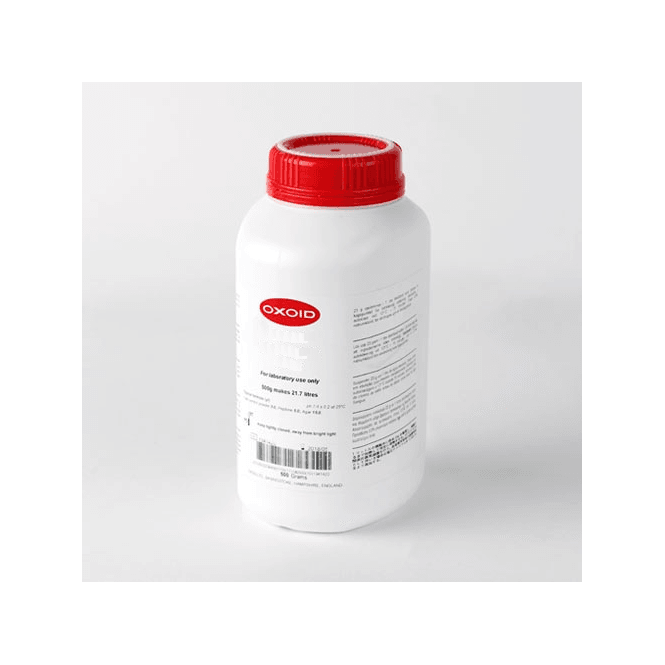Thermo Scientific™ Oxoid™ Dichloran Rose-Bengal Chloramphenicol (Drbc) Agar Base, 500G
Catalog No :
CAS Number :
Brand :
In Stock
Specifications:
| Application | Microbiology | ||
| Storage Temperature | Room Temperature | ||
| Product Type | Culture Medium | Forms | Powder |
| Product Brand | Thermo Fisher Scientific™ | ||
| Product Grade | Microbiology grade | Formula | For 15.9L medium |
The Dichloran Rose-Bengal Chloramphenicol (DRBC) Agar Base is a selective medium designed for the isolation and enumeration of yeasts and molds associated with food spoilage. This medium inhibits the growth of spreading molds and bacteria, facilitating easier colony counting and enabling the isolation of species not cultivable on standard media such as Rose-Bengal Chloramphenicol Agar or Acidified Potato Dextrose Agar.
Composition
Typical Formula (per liter of dehydrated medium):
| Component | Amount (g/L) | Purpose |
|---|---|---|
| Peptone | 5.0 | Provides essential nutrients, including amino acids and peptides, to support the growth of yeasts and molds. |
| Glucose | 10.0 | Serves as the primary carbon source for energy metabolism, promoting fungal and yeast growth. |
| Potassium dihydrogen phosphate | 1.0 | Acts as a buffering agent to maintain the medium's pH at an optimal level for fungal isolation. |
| Magnesium sulfate | 0.5 | Provides essential magnesium ions required for enzymatic activities and fungal metabolism. |
| Dichloran | 0.002 | Inhibits the growth of spreading molds (e.g., Rhizopus and Mucor), improving colony isolation and size. |
| Rose-Bengal | 0.025 | Controls colony size and prevents overgrowth, making it easier to enumerate yeast and mold colonies. |
| Agar | 15.0 | Solidifies the medium, providing a stable surface for the growth of fungi and yeasts. |
| pH (at 25°C): 5.6 ± 0.2 | Enhances the selectivity of the medium by inhibiting bacterial growth while promoting fungal development. |
Features and Benefits
- Selective Properties:
- Dichloran: Inhibits the growth of spreading molds such as Rhizopus and Mucor.
- Rose-Bengal: Controls colony size and prevents overgrowth.
- Chloramphenicol (added separately): Suppresses bacterial growth.
- Improved Isolation:
- Designed for isolating and enumerating yeasts and molds significant in food spoilage.
- Supports species not isolable on other media like Rose-Bengal Chloramphenicol Agar.
- Ease of Use:
- Clear, defined colonies make counting straightforward.
Applications
- Primary Use:
- Isolation and enumeration of yeasts and molds from food samples.
- Industries Served:
- Food safety and quality assurance labs.
- Research institutions focused on mycotoxin-producing molds.
- Specific Applications:
- Detection of spoilage organisms.
- Isolation of molds that produce mycotoxins.
Preparation and Protocol
1. Preparation of Medium
- Suspend 31.4 g of the dehydrated medium in 1 liter of distilled water.
- Heat with frequent agitation until the powder is completely dissolved.
- Autoclave at 121°C for 15 minutes to sterilize.
2. Addition of Chloramphenicol
- Reconstitute the chloramphenicol supplement (0.05 g per vial) as per manufacturer instructions.
- Cool the medium to 45–50°C and aseptically add the reconstituted chloramphenicol to the sterilized medium.
3. Plating Procedure
- Pour the medium into sterile Petri dishes and allow to solidify at room temperature.
- Store plates at 2–8°C if not used immediately.
4. Inoculation and Incubation
- Spread the sample or diluted specimen evenly over the agar surface.
- Incubate at 25–30°C for 2–7 days, depending on the organism.
5. Enumeration
- Observe and count colonies.
- Record colony morphology to differentiate between yeasts and molds.
Quality Control
Recommended QC Strains and Results:
| Organism | Expected Result |
|---|---|
| Candida albicans | Moderate growth; creamy colonies |
| Aspergillus brasiliensis | Good growth; dark sporing colonies |
| Escherichia coli | No growth |
Comparison with Other Media
| Feature | DRBC Agar Base | Rose-Bengal Chloramphenicol Agar | Acidified Potato Dextrose Agar |
|---|---|---|---|
| pH | 5.6 | 6.0 | Acidified (4.5) |
| Selective Agent | Dichloran, Chloramphenicol | Chloramphenicol | Acidification |
| Rose-Bengal Content | Reduced (0.025 g/L) | Standard (0.05 g/L) | None |
| Spreading Mold Inhibition | High | Moderate | None |
| Application in Food Spoilage | Excellent | Moderate | Low |
Advantages
- Enhanced Selectivity: Incorporation of Dichloran inhibits spreading molds and unwanted bacteria, making it highly effective for food microbiology.
- Optimized Colony Counting: Controlled colony size due to Rose-Bengal ensures accurate enumeration.
- Broad Applicability: Suitable for a wide range of yeast and mold species, including mycotoxigenic molds.
- Ease of Use: Straightforward preparation with clear instructions for supplementation.
Specifications
- Form: Powder.
- Quantity: 500 g.
- Yield: 15.9 L of medium per 500 g.
- Certifications/Compliance: NMKL Standards.
References
- King D. A. Jr., Hocking A. D., and Pitt J. I. (1979). Journal of Applied and Environmental Microbiology, 37: 959–964.
- Pitt J. I. (1984). Personal Communication.
- Jarvis B. (1973). Journal of Applied Bacteriology, 36: 723–727.
- Thomson G. F. (1984). Food Microbiology, 1: 223–227.




 0
0
